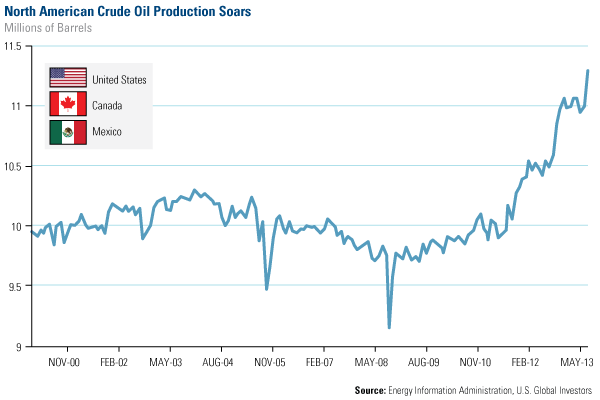Energy and Natural Resources Market Radar (December 2, 2013)
Strengths
- Natural gas futures climbed over 4 percent this week to the highest level in five months nearing $3.83 per million British thermal units (mmbtu). Cold weather across much of the country boosted heating demand.
- Gold bullion closed up this week by nearly $10 per ounce as the U.S. dollar index weakened to a three-week low.
Weaknesses
- Crude oil futures slid 1 percent this week as an interim agreement with Iran regarding its nuclear program diffused geopolitical risk and raised the possibility of Iranian supply coming back to the market in the future.
- Aluminum prices closed at a four-year low of $0.80 per pound this week on signs that global supply will outpace demand in an already well-supplied market.
Opportunities
- In a move designed to combat overcapacity in the steel sector, China will relocate some factories and encourage more companies to invest in overseas projects, said an official with the country's top planning agency. Li Zhongjuan, an inspector of industrial planning for the National Development and Reform Commission (NDRC), said the country will continue to optimize the steel sector through industrial transfers and directing capacity to areas with comparative advantages. In the meantime, the NDRC will ratchet back new projects and take on existing, outdated production through legal and market-oriented means, Li said at a recent conference of the China Iron and Steel Association.
- The fastest growth ever within U.S. crude output will mean a supply glut as soon as 2015, spurring the industry to challenge a 38 year ban on most exports. Refineries in the Gulf Coast, East Coast and Canada can handle another 1.75 million barrels a day before becoming saturated in the first half of 2015, causing domestic prices to fall relative to international grades. The U.S. will have to expand plants, curb output or allow exports, according to Washington-based PFC Energy, a consulting unit of research company IHS Inc. Most of the growth in the U.S., poised to become the world’s largest producer by 2015, is in lighter grades extracted from shale rock formations. Many refineries are configured for heavier crudes from the Middle East and Latin America. That mismatch is creating a surplus of domestic supply with nowhere to go, raising pressure to ship oil overseas. The industry’s push to export will face resistance from members of Congress concerned that gasoline prices would rise. Senator Ron Wyden, an Oregon Democrat who chairs the Energy and Natural Resources Committee, would need to see benefits to consumers before supporting such a move, spokesman Keith Chu wrote in a November 6 email.
- For decades, governments dreamed of harnessing the Congo river's enormous energy at the Inga rapids with an expansion of the dam large enough to power half of Africa. Years of conflict and misrule in the Congo meant the project was never realized. Instead, in the cavernous halls of Inga's two dams, water drips from the ceiling and rusted pipes sit above puddles. Five of the 14 turbines no longer spin at all, a sign of the decay. Now a deal with South Africa to buy electricity from Inga has revived talk of the giant hydro project that could illuminate a continent whose economies are rapidly expanding but lack the power supply to sustain it. "We had to find a buyer for this energy. Otherwise we cannot build Inga," Bruno Kapandji, Congo's minister of energy and hydro power, told Reuters. "South Africa is a solvent and credible buyer," he continued. Following a year of talks, South Africa has promised to buy at least half the electricity from Inga III, a $12 billion dam that, once built, will produce 4,800 mega watts (MW) of energy. Much of the rest may go to the Congo’s power-starved mining industry. This is nearly three times the amount produced from Inga's two existing dams, which are decades old and have been crippled by neglect, government debt and risk-averse investors. Success for Inga III would help to raise investors' confidence in the remaining five stages of the Grand Inga project. At an estimated cost of $50 to $80 billion, Grand Inga would produce 44,000MW, dwarfing all other hydro-electric projects in the world, including China's Three Gorges Dam. "This incredible feat of human ingenuity, when completed, will have the capacity to power Africa and indeed to export electricity beyond the continent," South African President Jacob Zuma said at a signing ceremony in Kinshasa.
Threats
- The Las Angeles Times reports, “India is now the world's third-largest grain producer after China and the United States.” The adoption of higher-yielding crop varieties and the spread of irrigation have led to this remarkable tripling of output since the early 1960s. Unfortunately, a growing share of the water that irrigates three-fifths of India's grain harvest is coming from wells that are starting to go dry. This sets the stage for a major disruption in food supplies for India's growing population. In recent years, about 27 million wells have been drilled, chasing water tables downward in every Indian state. Farmers can also reduce water use by using more efficient irrigation techniques and by growing less thirsty crops. For example, more wheat and less rice.
- The Financial Times reported, “King Coal has lost its crown. Since prices spiked in the wake of the Australian floods of 2010 it has been all one way for thermal coal – down. But a rally in several coal benchmarks has brought the market back to life and raised hopes the fossil fuel, which is used to generate electricity around the world, might have bottomed. The Australian spot price has risen almost 9 per cent since its August low to $82.80 a tonne, while its South African equivalent is nearly 17 percent higher at $83.39. Yet the outlook for thermal coal remains poor. Supply continues to expand, with producers in Australia and Indonesia, the world’s biggest exporter, still to curtail output in the face of weaker prices.” One industry executive says, “There’s good demand everywhere, but there is just too much supply.” An unusually cold winter in the northern hemisphere and further disruptions in Colombia, which exports almost 70 percent of coal to Europe, could help support thermal coal. Most analysts expect prices to come under pressure in 2014, especially if demand from China weakens.
- The latest SteelBenchmarker assessment by World Steel Dynamics shows that the disparity in global steel prices continues to grow. U.S. domestic hot rolled coil (HRC) prices have risen to $736 per ton ($736/t), the highest since May 2012, and following domestic scrap prices upwards. In contrast, European hot rolled coil prices have slipped $10/t over the past fortnight, and remain well below levels seen in the first quarter this year, while Chinese domestic HRC prices also slipped to only $3/t over the low over the past 12 months. U.S. domestic prices are now trading at a $260/t premium to Chinese prices and a $177/t premium to the benchmark World Export price. According to Macquarie research, such arbitrages have proven unsustainable in the past, and seen substantial increases in U.S. steel import volumes.















